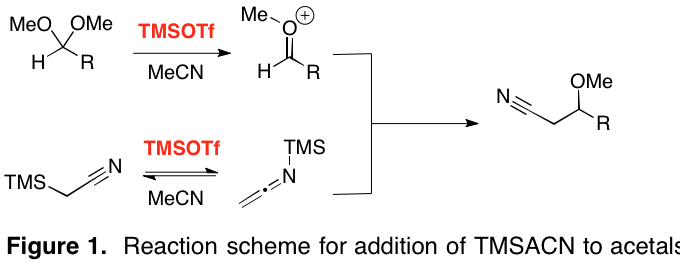Reports: UR155852-UR1: New Reactivity Mediated by Trimethylsilyl Trifluoromethanesulfonate
Chiles Wade Downey, University of Richmond
Introduction
The common goal of the projects described below is to discover new reactivity mediated by trimethylsilyl trifluoromethanesulfonate (TMSOTf) through its ability to react both as a Lewis acid and as a thermodynamic silylating agent. Over the past twelve months, the most signficant progress has been made in the addition of nitriles to various electrophiles and the activation of propargyl alcohols and carboxylates toward nucleophiles. Each area will be addressed in turn.
A. Addition of Nitriles to Acetals
Nitriles are common laboratory solvents and often function synthetically as masked carboxylic acid derivatives. The ability of (trimethylsilyl)acetonitrile (TMSACN) to act as a mild nucleophile in the presence of a nucleophilic catalyst has been adequately investigated, but we were more interested in the reactivity of a-silylnitriles under Lewis acidic catalysis. We recently discovered the ability of TMSACN to efficiently condense with dimethyl acetals. Over the past twelve months, we have almost completed our preliminary study in this field, which to our knowledge is unprecedented in the literature. Very preliminary results suggest this reaction does not occur in the presence of other common Lewis acids.
Our hypothetical mechanistic pathway is illustrated in Figure 1. The acetal is activated by TMSOTf to generate the reactive oxocarbenium ion. Simultaneously, TMSACN undergoes TMSOTf-catalyzed isomerization to its N-silylated tautomer. It is this isomerization where the reactivity of TMSOTf likely diverges from that of more traditional metal-based Lewis acids such as MgBr2·OEt2, TiCl4, and BF3·OEt2, none of which appear to be capable of mediating the present reaction. Mukaiyama-like attack of the silylated nucleophile upon the oxocarbenium ion and concomitant loss of a silyl group yields the b-methoxynitrile. This proposed mechanism is speculative but is our best explanation of the results at present.
A variety of different acetals have been reacted with TMSACN under similar conditions (Table 1). Most acetals derived from aromatic aldehydes react with good yields, although there was a drop in reactivity for the sterically demanding 1-naphthaldehyde derivative (entry 8) Electron-poor substituents were especially successful. Relatively electron-rich substituents, however, showed themselves to be prone to elimination, yielding significant amounts of the a,b-unsaturated nitrile in addition to the b-methoxy product. These elimination reactions depressed the yield of the tolyl derivative (entry 6), and dominated the reactivity of the 4-anisaldehyde derivative (not shown). The cyclohexyl substrate shows that reaction is at least possible for aliphatic residues, and is unique in that the desired product was isolated as mixture containing about 10% of the N-alkylation product.
Outlook and Impact
The preliminary phase of the silylnitrile project is virtually complete, pending control experiments and final characterization of the reaction products. We expect publication within one year. Followup projects will focus upon a diastereoselective version of the reaction and the possibility of favoring a,b-unsaturated nitrile products. This result has some importance for the career of the PI because it is the first example of TMSOTf-catalyzed reaction to appear from the group that does not require an amine base as co-catalyst. Extension of the proposed mechanistic pathway to propargyl silane substrates would be a major new direction for our group, and remains of a major goal of this funding period. The student who worked on this project and whose stipend was provided by ACS-PRF, Jack Goodin, has decided upon a career as a research scientist upon his graduation in 2018.
B. Reactivity of Propargyl Alcohols and Propargyl Carboxylates
As mentioned above, the synthesis and reactivity of propargyl silanes is a major goal of our research group. One of our early attempts to synthesize propargyl silanes involved the activation of propargyl alcohols with silyl triflates. Although attempts to trap the resultant propargyl cations with silyl anions failed, ionization of the substrate was very successful under our conditions and the cation could be easily trapped by the simple hydride source triethylsilane (eq 1).
We speculated that this ionization method would be compatible with the in situ production of enol silanes from ketones using TMSOTf and an amine base. When the propargyl alcohol was added to the enol silane-formation reaction mixture, however, simple silylation of the hydroxyl group was the major product. Replacement of the alcohol with a propargyl acetate or propionate, however, gave rise to the desired alkylation pathway and yielded primarily the g-alkynyl ketone (eq 2). Minor amounts (typically 5-10%) of the allene product were often observed.
Optimization of the reaction across a range of ketones proceeded with good results (Table 2), and the reaction was recently expanded to include a thioester substrate. In general, more consistent results are observed if the acetate leaving group is replaced by a propionate, which slows the ionization step somewhat and helps to prevent rapid decomposition of the propargyl substrate.
Outlook
Preliminary results suggest that we can expand this reaction to include other propargyl carboxylates, i.e., the aryl rings on the propargyl substrate can be modified or replaced. Determination of that portion of the reaction scope is a short-term goal. Furthermore, cyclization of similar products to yield furans is known in the literature, although not for our series of highly aromatized structures. Accordingly, the cyclization reaction will be studied in due course. Other recent results include the expansion of the reaction manifold to include allyl carboxylates and even allyl methyl ethers. This group of reactions should yield multiple publications and become the major focus of my group for the next few years. The student who primarily developed this project, Danielle Confair, graduated in May 2016 and will attend graduate school in chemistry at Yale University next year. Two new students have taken on the project: Xuechun Lin plans to attend chemistry graduate school, and Yiqi Liu plans a career in medicine.
Note: A fourth student, Chris Poff, has been funded by ACS-PRF as well. His project is in its infancy, but he has discovered a reliable way for indoles to undergo Friedel–Crafts addition to nitrones in the presence of TMSOTf and an amine base. Chris plans to attend graduate school in chemistry.














